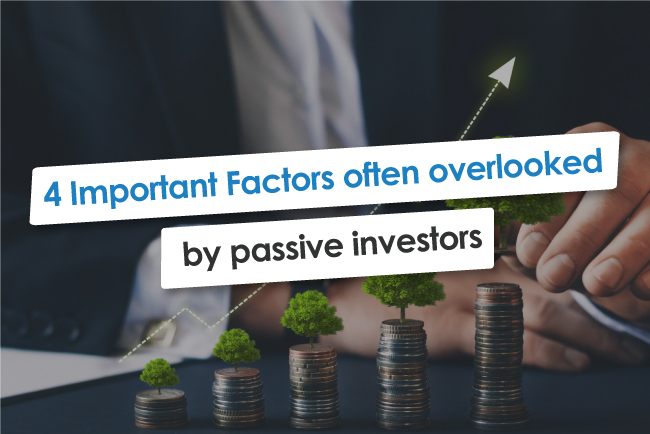Introduction:
Passive investing has gained tremendous popularity recently, offering a low-cost and relatively hands-off approach to wealth accumulation. However, amidst the ease and simplicity of passive investing, crucial factors often go unnoticed by many investors. In this blog, we will uncover four important considerations passive investors should consider to optimize their investment strategy and enhance their long-term returns.
4 Important Factors often overlooked by passive investors
Asset Allocation:
While passive investing primarily involves index funds or exchange-traded funds (ETFs), the significance of asset allocation must be stressed more. The decision to allocate investments across different asset classes, such as stocks, bonds, real estate, and commodities, can profoundly impact portfolio performance. Consider your risk tolerance, investment goals, and market conditions when determining the ideal asset allocation mix. Additionally, periodically rebalancing your portfolio to maintain the desired allocation can help mitigate risk and capture potential opportunities.
Fund Selection:
Although passive investors typically rely on index funds or ETFs, not all funds are created equal. Investors must dig deeper and consider factors beyond just low expense ratios. Factors such as fund size, tracking error, liquidity, and the fund provider’s reputation should also be evaluated. Furthermore, analyzing the underlying index methodology, diversification, and exposure to specific sectors or geographies can assist in selecting funds that align with your investment objectives.
Dividend Reinvestment:
Dividends are often considered an attractive feature of many passive investment vehicles. However, passive investors often need to pay more attention to the power of reinvesting these dividends. Investors can purchase additional shares using the dividends received by opting for dividend reinvestment programs (DRIPs). Over time, compounding returns can significantly enhance long-term wealth accumulation. Therefore, passive investors should explore the feasibility of DRIPs offered by their chosen investment vehicles to maximize the potential benefits of dividend income.
Tax Efficiency:
Tax efficiency is a critical aspect of any investment strategy. While passive investing is known for its tax advantages, investors must consider potential tax implications. For instance, passive investment vehicles such as ETFs may generate capital gains when shares are sold. Understanding the tax implications of such events and considering tax-efficient strategies, like tax-loss harvesting or investing in tax-advantaged accounts, can help minimize the tax burden and preserve more of your investment returns.
Related Multifamily Real Estate Investing 101: A Passive Investor’s Guide
Conclusion:
Passive investing offers numerous benefits for investors seeking a straightforward and cost-effective approach. However, it is crucial to recognize the often-overlooked factors that can have a significant impact on a passive investment strategy’s success of a passive investment strategy. By considering asset allocation, fund selection, dividend reinvestment, and tax efficiency, investors can optimize their portfolios and position themselves for long-term success. Remember, even in a passive approach, staying informed and attentive to these factors will enable you to make the most of your investments.

